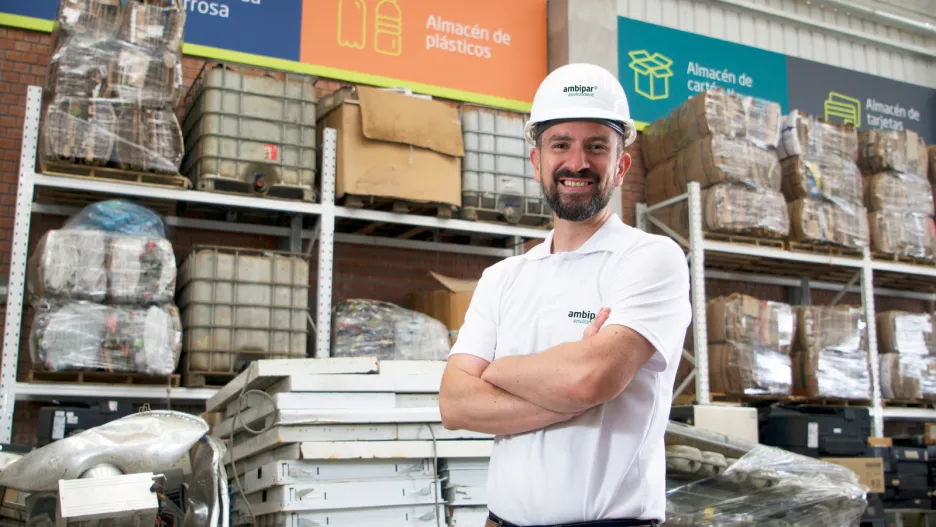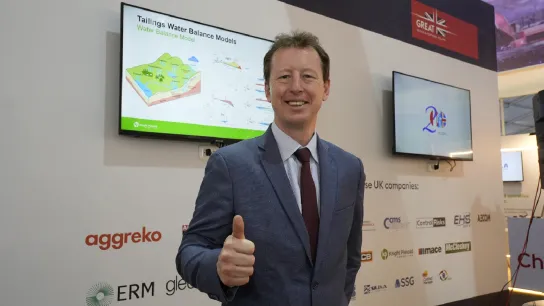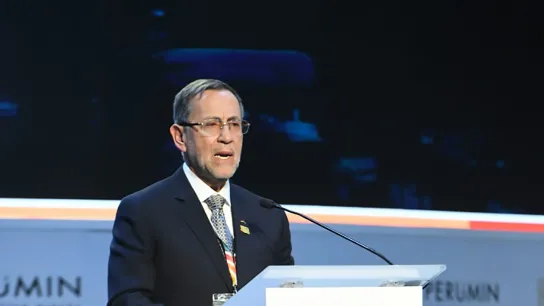Pablo Miranda: At PERUMIN, More Than 80% of the Waste Was Repurposed in other Productive Processes
Lima,

PERUMIN 36 is partnering with Ambipar Environment to efficiently manage the waste generated during the mining convention. This waste includes materials like cardboard, metals, and plastics. Ambipar will divert these materials into recycling chains, where they will be transformed into new products. This approach not only reduces the need for natural resources but also minimizes the ecological footprint, as highlighted by Pablo Miranda Gonzáles, Ambipar's general manager, in this interview.
What strategic role will Ambipar play in this edition of PERUMIN 36?
Ambipar will play a strategic role by providing comprehensive waste management solutions for the event to ensure that PERUMIN 36 is held as a sustainable and responsible event, promoting best practices in the industry and prioritizing recycling and proper waste treatment. Minimizing impact is our priority.
How will you carry out the segregation, classification, and treatment of the generated waste?
First, source segregation will be implemented, sorting waste into categories such as plastics, metals, organic materials, and more. Once classified, the waste will undergo tailored treatment processes based on its characteristics. These processes may involve recycling, composting, chemical treatments, or physical methods, depending on the specific nature of the waste. It is important to note that all these recovery and treatment options will be overseen by locally accredited companies with the support of Ambipar.
It is worth noting that Ambipar has a waste management process focused on offering solutions that maximize the value of waste and minimize logistics costs:
Waste Segregation Training Plan: A training plan involves employees ensuring proper waste segregation at the source. This ensures that waste is correctly categorized from its origin.
Manuals for optimizing waste management and segregation: These manuals serve as practical guides for participants and employees, ensuring consistent and high-quality waste management.
Implementation and operation of the Industrial Waste Valorization Center: The operation of the center identifies those waste materials that can be more effectively valorized or recycled. This reduces the amount of waste sent to final disposal.
What technological solutions will you use for these activities?
Currently, we have a waste management software called Resflow. This software allows monitoring management at collection points, collection, and waste yard management. The software is operated through an application or web platform that enables users to monitor service compliance, quantities of waste handled, waste inputs and outputs, and even report incidents such as segregation errors at collection points. It is an added value that Ambipar offers to all its clients for information management.
What secondary uses will you seek for the waste produced during the event?
Recyclable waste, such as plastics and metals, will be directed to recycling chains for reintegration into the production of new products, minimizing the demand for natural resources. In addition to the environmental focus, we have a partnership with Aniquem and promote our joint campaign "Recycle +, Love to Heal," in which a percentage of the value recovered from the waste has a social focus to support children with burns.
How much waste was generated at PERUMIN 35, and what volume was valorized?
In the last edition of PERUMIN, we managed more than 70 tons of waste. Of that amount, more than 80% was utilized in other productive processes. Metals, wood, and even organics for composting were utilized. All these processes comply with traceability and documentation requirements.
How will the mining convention be able to verify what has been done with waste management?
Waste management will be transparent and thoroughly documented. Detailed reports will be provided describing the quantity and type of waste generated, as well as the specific management actions to be carried out.
Additionally, communication measures will be implemented during the event to inform participants about the importance of proper waste management and to promote active participation in sustainable practices.
Finally, as Ambipar Environment, we will provide the corresponding certificates for each waste management process. As an environmental company, it is a priority for us that all our clients have the documentation justifying waste management.
What types of waste are most commonly generated in mining activities?
In mining activities, various types of waste are generated, which we can classify as hazardous and non-hazardous. On the hazardous side, the most common waste includes tailings and processing sludges containing chemical substances, chemical waste from extraction processes, rock and demolition waste contaminated with hydrocarbons. These are currently being managed within each mining unit. Other relevant hazardous waste includes oil waste from heavy machinery maintenance, contaminated containers, waste from explosives used in rock fragmentation, and end-of-life tire waste (ELTs).
On the non-hazardous waste side, we have scrap metal, various types of plastics, cardboard, organic waste, machinery and equipment waste used in mining operations, and construction and demolition waste.
As Ambipar Environment, we are constantly working on solutions to maximize the valorization of both hazardous and non-hazardous waste. We are currently constructing our Mining GIRI (Comprehensive Industrial Waste Management) complex in Arequipa to serve all our clients in the southern region of the country.
How is the process of comprehensive waste management carried out, and where does it take place?
Comprehensive waste management in mining involves several key steps, including waste characterization, design of segregation and internal management systems, design and operation of waste collection yards, collection, transportation, and management of solid and liquid waste (both hazardous and non-hazardous, as well as biocontaminated). It also includes waste treatment, landfill management, and final disposal. All these processes are carried out in specific facilities at the mines and in authorized waste management centers.
Currently, we serve more than 15 mining projects nationwide. The most important ones include Antamina, Cerro Lindo, Cerro Verde, Minsur San Rafael, Las Bambas, Constancia, Minera Volcan, Minera La Arena, and Gold Fields.
What are the products or raw materials obtained from waste?
At Ambipar Environment, we are constantly seeking circular solutions for the waste generated by our clients. We have an ongoing R&D process through which we frame waste valorization using two key approaches:
Short-Cycle Circular Economy: In this approach, valorized waste is used internally by the client for their processes or products, thus contributing to closing the resource cycle sustainably.
Integrated Circular Economy: In this case, valorized waste leaves the generator and can be used by other industries or companies, promoting reuse and maximizing resource management efficiency.
Some successful cases are the solutions that have been implemented and tested for:
- Ferrous and non-ferrous scrap: Reinserted into local and foreign foundries
- Organics: Used for compost and biol
- Wood: Upcycling (furniture for the local area, recycled wood containers), chipped for compost.
- E-waste (WEEE): Valorized in our GIRI LIMA SUR plant
- Plastics: PET, HDPE, PPBD, etc. Reinserted into production industries.
- End-of-life tires (ELTs): Valorized with strategic partners.
- Waste oils: Valorized with strategic partners.
We are currently in the process of constructing a complex for the valorization of hazardous waste.
Why are waste classification and disposal challenges for mining companies?
These processes pose significant challenges due to several key factors. One of them is the diversity of waste generated. Each type of waste has different characteristics, such as chemical composition or potential toxicity, which requires specific management approaches.
Being a large-scale activity, mining generates massive volumes of waste, which needs classification and disposal to avoid unwanted accumulation and prevent contamination.
Effective management is crucial to comply with regulations and prevent negative environmental impacts, such as soil and water degradation and contamination, which can adversely affect local communities and the surrounding ecosystem. Additionally, ensuring worker safety and handling massive waste volumes requires logistical planning.
At Ambipar Environment, we are convinced that source segregation and classification are vital for the recovery chain, reduce treatment logistics costs, and allow for the highest value of the waste. It is a commitment of all actors in the chain.
How much mining waste did you collect in 2022, and what percentage was reused?
In 2022, we managed over 45,000 tons of waste from our mining projects, 29% of which we have reused in various processes. There is still a significant challenge ahead in terms of circular economy. That is why Ambipar is investing in our Comprehensive Industrial Waste Management (GIRI) plants nationwide with the aim of addressing the infrastructure gaps for proper waste recovery. In 2024, we will begin operations at our GIRI MINERO facility in Arequipa with the goal of capturing and utilizing waste from the southern region of the country.

